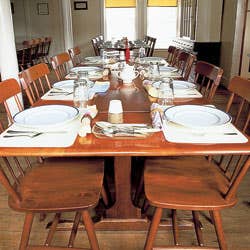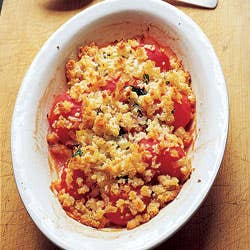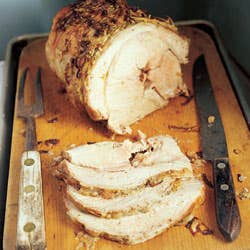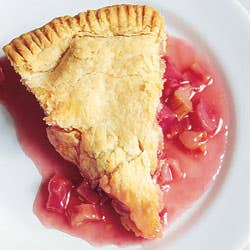
The Shaker Table
This last surviving community of Believers lives, works, and cooks with common values and uncommon togetherness
I am a file keeper. Bulging manila folders hold a lifetime of clippings, recipes, brochures. In the middle of my otherwise orderly file on the Shakers, among typewritten pages of Shaker history, is a piece of yellow paper bearing a message I scrawled to myself one day years ago: "We are unresolved about direction, unfulfilled about community. Why are we here on Earth?"
The Shakers, descendants of an ascetic 18th-century English-born religious group, strive to live a life of meaning through work and worship. Their motto "Hands to work and hearts to God" still speaks to me and—along with that heartfelt question to myself on yellow paper— helped inspire me, more than 20 years ago, to begin visiting every one of the eight remaining Shaker villages in America.
Today, unfortunately, the Shakers—officially, the United Society of Believers—are far more famous for their furniture than for their religious beliefs. For the Believers, work and religion go hand in hand. "Do all your work as if you would live a thousand years and as if you might die tomorrow" is another of their mottoes. Their wonderful craftsmanship, sense of proportion, and commitment to simplicity—an expression of all they believed—produced some of the most beautiful American furniture ever made. (In spite of Shaker philosophy, which embraces Christian poverty and eschews ownership of personal property and self-aggrandizement, Shaker-made antiques in today's secular marketplace bring almost obscene amounts of money; the objects are valued far more than the impulse and spirit behind them.)
In the course of my pilgrimage, I visited Pleasant Hill, a Shaker settlement near Lexington, Kentucky. Like most of its counterparts, it had long since ceased being a working community, and—as with many of the others—its buildings had become a museum. But you could stay there. In my room at Pleasant Hill, there was a chair hanging on the wall (the Shaker way of good housekeeping); one very small, simple bed; and, next to the bed, a little chest of drawers with a lamp on top. When I walked in I thought, How strange to live in such a barren room with no ornament, no clutter. But by the end of the second day, the room had begun to feel better to me. Its order and serenity seemed to clear my mind. With little else to take in, my eye settled on the beautiful trees that were gracefully framed by the room's long windows. And I decided that when I got home, I would have the world's biggest garage sale.
In 1980, I first visited Sabbathday Lake, in New Gloucester, Maine, now America's last remaining working Shaker community, and met Sister Frances A. Carr—one of the last practicing Shakers in America and the author of a 1985 cookbook called Shaker Your Plate: Of Shaker Cooks and Cooking. It is a work filled with food that reflects the Shaker spirit: uncluttered, balanced, and never more complicated or "fancy" than it needs to be. Shaker food, writes Sister Frances, is basically "plain, wholesome food", and her collection of recipes "is intended for those people who enjoy simple foods painstakingly prepared".
But there's much more to this cooking than just the way it is made: I discovered that for Sister Frances, as for the sisters who work with her in the kitchen, cooking meals for others means more than giving nourishment; it means thoughtfulness and caring for and strengthening relationships. I discovered how Shaker food carries out the Shaker mission.

Out in the world, the very acts of cooking at home and eating together are rapidly fading from our lives; shared home-cooked meals are no longer the rule but a holiday exception. This is a loss with great consequence. Years ago, there was only one way to learn to cook, and that was to watch someone else cook in the kitchen at home. Today, most home kitchens are empty, and people try to learn what cooking they're interested in from some celebrity chef on television. But you can't learn to cook from watching TV; it's so removed from reality—you never touch the food, never smell the food. Maybe that's why so many people buy their food already prepared, in boxes or cans or bags—or go out to terribly noisy restaurants where nobody can talk to anybody. Communal events like the family dinner have been sacrificed to individual agendas. But coming together at the table is a reminder that you are part of something bigger than yourself. You are exposed to your family in a very real way, sitting at a table, facing one another. It's a metaphor for life. As a platter is passed, you learn to take only what you need and leave enough for others. We were not born civilized; eating together civilizes us. As Sister Frances puts it, "Nothing seems to bring people closer together than the act of sharing food."
Three times a day, the Shaker family at Sabbath-day Lake does just that, gathering for a family meal, saying their prayers and passing their food—food that comes from the community's kitchen and also from the community's past. Sister Frances, as a girl, learned from Sister Ethel Peacock how to mold butter into long rolls for the table.
Shaker Lemon Pie
This sourish pie, with its marmalade-like filling, is said to have been a specialty of the Ohio branch of the Shaker community. See the Recipe for Shaker Lemon Pie
From Eldress Prudence Stickney she divined the secrets of making mincemeat; with Sister Elsie McCool, she practiced canning chicken. She watched as Sister Mildred elevated ordinary leftover boiled potatoes by adding plenty of rich butter and cream from the community's dairy cows and slowly stirring the potatoes in a cast- iron pan until they had absorbed every delicious drop. She picked up favorite recipes shared among many of the communities, like Shaker stewed tomatoes and Shaker lemon pie, with its tart, marmelade-like filling. And she mastered the Sabbathday Lake specialties, like scalloped tomatoes with a crispy bread-crumb crust, made from their own tomatoes, which they can every autumn. Ever open to new ideas and influences, the community kitchen perfected the late Brother Ted Johnson's Swedish meatballs and always serves them at Christmas; from Brother Arnold they adopted a very Italian lasagne with meat sauce. It was Brother Delmer Wilson who taught Sister Frances to "shaker your plate"—which means never to leave a precious crumb.
When harvesting garden rhubarb, choose tender, young shoots, discard the rhubarb leaves—which are toxic—and peel any large, tough stems as you would with celery. Commercially grown rhubarb doesn’t need peeling; buy only firm, crisp stalks, and store them in the refrigerator. See the recipe for Shaker Rhubarb Pie »
The Shakers call Sabbathday Lake "the Chosen Land" and are as self-sufficient here as it is possible for them to be. They grow and preserve most of their own vegetables and fruit, keep a couple of beef cattle, and raise sheep for wool; they make pickles and jams and relishes, both for their own use and for sale, and grow, dry, and sell dozens of kinds of herbs and teas, which they package in tin canisters to prolong freshness. It is the homegrown herbs—the community currently prepares more than two dozen varieties—whose flavor infuses so much of their cooking and puts the definitive Shaker thumbprint on their recipes.
At Sabbathday Lake, ten minutes before mealtime, a bell is rung, calling the community together. In the large dining room, similar to those that once fed some 170 hungry souls in shifts, now just two tables are set, one for the Brothers and male guests and the other for the Sisters and female guests like me. (The Believers address one another with familial terms like Brother and Sister as a ritual that emphasizes their closeness.)
Over the years, I have managed to visit Sabbathday Lake three or four times, and each time, even before I leave, I am filled with a desire to return. The contrast between their world and mine is what so moves me. What will happen if the Shakers disappear? I sometimes wonder. We won't have anyone to compare ourselves to. We won't have that standard to look at; when they are gone, we shall forget.
Now, it is not as if Shakers were these perfect human beings, just singing, cooking, and making chairs all day. In fact, aside from the occasional object, no significant furniture has been crafted at Sabbathday Lake for more than a hundred years. (A wonderful BBC documentary about the community took as its title a remark by Sister Mildred—who died at 92 in the winter of 1990 just before the film was shot—"I don't want to be remembered as a chair.") Sadly, in fact, it seems that some of the community's valued furnishings have had to be sold over the years to sustain the family. Many remaining pieces now reside at Sabbathday Lake's museum.
But the Shakers trust in their community and believe that their faith will tell them the right way to live. They have the satisfaction of their work and share the goal of doing whatever

they undertake as perfectly as they can. And—this is the great thing—they're not looking for a reward. The Shakers have taken care of their own payback. They've made peace with the world they've chosen, and surely they feel that their rewards are enormous. It must be something, to have that kind of peace in your life.
I'll never forget sitting at the breakfast table on the last morning of my most recent visit to Sabbathday Lake. I was about to return to my busy life out in the world. Later that day, I would get on a plane and fly back home to California to teach a cooking class, then go off again to promote a book I had just written. The early morning news reported that a hurricane was roaring up the East Coast, and as we were at breakfast that morning the rain was just beginning to fall. While we were sitting there, Sister Frances began singing, and everyone joined in so sweetly, the way they do. And they just sang out so unselfconsciously, so clearly: "Falling, falling, like the fleecy snowflake / Dropping, dropping like the gentle rain." And the rain was falling outside the window, and we were sitting inside at that table, and to me it felt like such a true moment.
Keep Reading
Continue to Next Story












